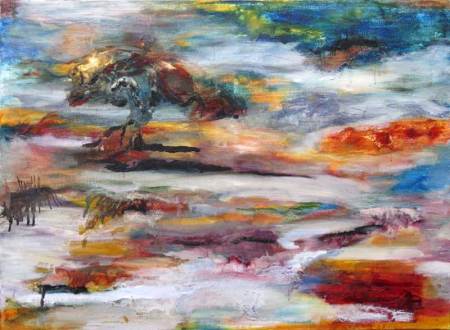Tree, Water (1), 20 x 30″, Oil and wax on canvas, 2010
It’s been a long dry spell, (an unfortunate cliché in spring-rain Portland from a person who like to paint deserts, but hey, I’m back).
At the very least, I’m back at southeast main, after relying almost entirely on Jer these last weeks to carry on the site and keep our loyal followers following. Thanks, Jer — and followers.
So, what’s up with me lately? Well, the other day I found an old container of Dorland’s Cold Wax, and just as, in the olden days, when people discovered sergers and serged through their houses edging everything they could find, I have been applying the cold wax on every old painting I have sitting around. (Thus far I’ve avoided waxing paintings other people did. I have lots of old (mediocre) paintings of my own to work on.)
Working with cold wax is a bit like working encaustics, although technically, encaustic paintings, done with heated beeswax and additives and then fusing multiple layers, requires pots of colored wax which sit on a heated surface and are brushed on the painting surface as a liquid. Many layers may be added to achieve the mystic and misty effect of encaustic paintings.
Cold wax is a bit like butter at room temperature and can be used with oil paint as a medium to make a translucent matte. I like the texture and the calming matted effect of the combined cold wax and oil, but at some point I realized I could heat the wax/oil combination after it was applied to the canvas. The heat from the heat gun causes the wax to drip and run, and it can be pushed around by the air from the heat gun, much as I used to do with wet textile paint or watercolor and a sprayer. I was instantly addicted.
Tree, Water (1), detail
On a canvas underpainted with acrylic or oils in a traditional manner, the wax can be pushed away from the surface to reveal the acrylic color underneath. So the layers on Tree, Water (1) vary from heavy dripping slabs and drooling drips to weave-revealing thinness.
It seems to me, in these early stages, that some scenes — like water and drippy trees — would work better than others — architecture, for example, where drips and runs might feel unstable. But the experimentation and discoveries have given me new things to think about as I struggle with scenic Portland, a land of lushness, perhaps more suited to drippy waxers than driven limners. –June



I thought you are not supposed to heat cold wax because it has solvents. I read that you do. I also read that it could affect its archivability. I would really appreciate any feedback because I think heating it is a nice effect. Thank you.
LikeLike
Hi Lorraine, you are right about the solvents. I heated the cold wax in a very open environment with an industrial fan pulling the fumes away from me. I know nothing about archivability — if you can handle the toxicity with your working environment (which isn’t good, but because it’s mixed with beeswax, is less than, say, other oil paint solvents), then further research on archivability would be worthwhile. I would think that in transportation, making sure it doesn’t sit in a very hot environment would be essential. And the beeswax tends to yellow over the years. So those are two considerations I would consider when thinking about working with this material. The results, however, are fantastic. So it’s a balancing act.
LikeLike
Don’t heat the cold wax. The fumes are super toxic.
LikeLike
Lia, I could use Bo’s methodical input. Although I think his job is a bit larger than mine. But maybe over time….
Thanks, Sheila and Del. Jer lost a bunch of photos in a hard drive crash, so his efforts here have been extraordinary. But then, that’s my jer!
LikeLike
Nice to have you back. Thanks to Jer for the photos. Love, Del
LikeLike
Well that looks like a bit of fun! Very cool effects.
LikeLike
Maybe you should come down and use our garage as a studio. You and Bo are both studying chemicals to put on and take off painted surfaces!
LikeLike